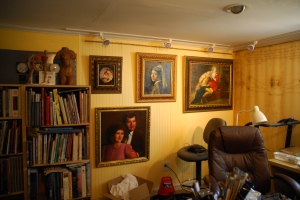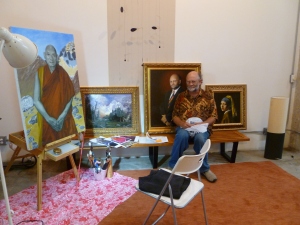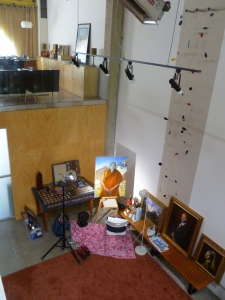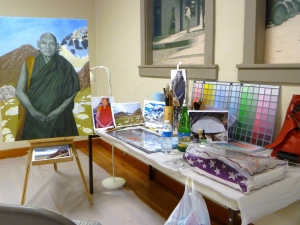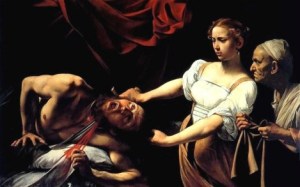As much fun as it isn’t, you just have to make a little studio space wherever you can. I am on my third (+ a temp or two) in the past ten years, and am eagerly awaiting my fourth, being built to specs by my husband and myself.
We live on ten-acres in the desert. Today it was 114 degrees so, of course, I stayed indoors. We are building our own house and if I find something that needs changing, we can do it ourselves. We’ve worked on this a long time, paying as we go, so money is always the issue (as it is for 99% of us).
Anyway, as a result of this state of continuing construction, I started out in a little corner of our household goods storage trailer, and here was my first painting space, among the washer, dryer, boxes, and books:
I quickly ran out of space so we enclosed the screen porch attached to the front of our travel trailer, turned it into a 7’x12′ kitchen, and the art moved in, quickly appropriating any extra cooking and eating space we had gained. Here it is with all the paintings I was working on at the time, complete with new red shoes and the first half of the Laurel and Heidi show:
And here is the second sleepy half, Heidi:
Finally, we decided we really needed that kitchen space so we restored a derelict 10’x16′ adobe (Surprise! The Golden Mean, 1:1.6) that came with the property, tearing out its wooden floor to find everything from rattlesnakes, to our missing jobsite Sharpies and paint stirrers stolen by the pack rats (I can understand the Sharpies, but how DID they get that long stick under that floor??). We replaced the floor with concrete, added interior beadboard walls, replaced the roof, added a door, two windows, a window AC unit, and special artist lighting. My husband now uses half for his temporary hamshack, and I use the other half as my studio. This penultimate 8’x10′ space is all mine–I’m moving up:
Then, my husband had a job in San Diego for a month, so I transported the supplies and my “feel good” paintings to our huge downtown loft accommodations. I didn’t know how to handle that much room so what did I do? Crowd in a corner, of course:
However, this is the quintessential upstairs studio I’m waiting for, although you have to use your imagination right now–but we painters have pretty good ones, no?
Bathroom, and balcony for sketching and painting in the Arizona winters.
Me, peeking around the balcony wall.
The studio spans the distance from balcony to dormer window, although the subfloor isn’t yet complete.
Here you can see the span. The dream studio will be about 25′ x 38′, plenty big enough for me!
Unretouched Arizona sunsets from the studio. Aren’t they amazingly beautiful?
And finally, during our Arizona Renaissance Art Guild workshops and our Frank Covino workshops held at the Gilbert Museum in Gilbert, Arizona, my space and that of all my artist friends, looks like this:
If you would like to join us sometime for one of our week-long workshops, or for our monthly Colony “paint togethers,” just let me know through this blog. We have a workshop coming up and as soon as I have solid dates, I will let you know.
All the best,
Marsha






